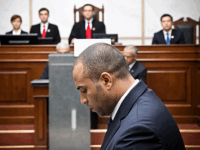Hedge Fund Founder, Portfolio Manager, And Trader Charged In Manhattan Federal Court With Mismarking Securities By Hundreds Of Millions Of Dollars
Former Hedge Fund Chief Risk Officer and Trader, and Former Salesman at a Broker-Dealer, Have Each Pled Guilty and are Cooperating with the Government
Audrey Strauss, the Attorney for the United States, acting under authority conferred by 28 U.S.C. § 515, and William F. Sweeney Jr., the Assistant Director-in-Charge of the New York Field Office of the Federal Bureau of Investigation (“FBI”), announced today the arrests of ANILESH AHUJA, a/k/a “Neil,” the founder, chief executive officer, and chief investment officer of a New York-based investment firm that managed hedge funds focused on structured credit products (“the Firm”), AMIN MAJIDI, a former partner and portfolio manager at the Firm, and JEREMY SHOR, a former trader at the Firm.
Ms. Strauss said: “Investors rely on a hedge fund’s performance numbers when deciding whom to trust with their capital. To compete with other peer funds, Neil Ahuja, founder of an investment firm, allegedly manipulated the firm’s performance numbers, using fraudulently inflated values for the firm’s securities holdings and lying to investors about how the firm would mark its positions. By allegedly cooking the books, Ahuja and his co-defendants made the fund appear more attractive to would-be investors and dissuaded current investors from withdrawing their investments. We will continue to work with our law enforcement and regulatory partners to ensure that investors are provided accurate information when making important investment decisions.”
FBI Assistant Director William F. Sweeney Jr. said: “The defendants’ alleged practice of intentionally misleading investors and mismarking securities held in the funds they managed allowed them to charge higher fees and hold captive money that would have likely been withdrawn had their clients been aware of the hedge fund’s actual value. Their initial success was based on self-imposed target returns, supported by reverse engineering tactics, but in the end, they missed their mark.”
AHUJA, MAJIDI, and SHOR are charged with participating in a scheme, from in or about 2014 through in or about 2016, to commit securities fraud and wire fraud relating to the mismarking of certain securities held in hedge funds that the Firm managed, thus fraudulently inflating the net asset value (“NAV”) of those funds as reported to investors and potential investors. At its peak, the mismarking across all funds managed by the Firm exceeded $200 million. In addition, Ms. Strauss announced today the unsealing of charges against ASHISH DOLE, a former chief risk officer and trader at the Firm, and FRANK DINUCCI, JR., a former salesman at a broker-dealer. Both DOLE and DINUCCI have pled guilty and are cooperating with the Government.
AHUJA was arrested in New York, New York, this morning. MAJIDI was arrested at his home in Armonk, New York, this morning. SHOR self-surrendered to the authorities in New York, New York, this morning.
AHUJA, MAJIDI, and SHOR will be presented and arraigned later today before United States District Judge Katherine Polk Failla. DOLE’s case is assigned to United States District Judge John G. Koeltl. DINUCCI’s case is assigned to United States District Judge Alvin K. Hellerstein.
In a separate action, the Securities and Exchange Commission (“SEC”) filed civil charges against AHUJA, MAJIDI, and SHOR.
According to the allegations in the charging documents unsealed today in Manhattan federal court, including the Indictment,[1] and statements made in court proceedings:
The Firm
As alleged in the Indictment, in or about 2008, ANILESH AHUJA, a/k/a “Neil,” co-founded the Firm, where he was the chief executive officer and chief investment officer. The Firm managed hedge funds focused primarily on structured credit products, including residential mortgage backed securities (“RMBS”). Before founding the Firm, AHUJA had been the head of the RMBS group at a prominent global investment bank.
The Firm’s flagship mortgage credit fund (the “Hedge Fund”) was launched in or about October 2009. A segregated ERISA fund held the same positions as the Mortgage Credit Fund. In 2013, the Firm launched a new fund (the “New Issue Fund”) that purchased and securitized pools of mortgages that were not issued or guaranteed by a government agency. At various relevant times between 2008 and 2016, the Firm managed billions of dollars in assets, in excess of $5 billion at the Firm’s peak.
From in or about 2008 through in or about June 2016, AMIN MAJIDI worked at the Firm, first as the chief risk officer and, beginning in or about 2014, as a partner and the portfolio manager for the Hedge Fund. From in or about early 2014 through in or about March 2016, JEREMY SHOR was employed by the Firm as a trader, where he focused on non-agency RMBS – i.e., RMBS securities that were not issued by a government agency.
The Scheme to Mismark Securities
As alleged in the Indictment, from at least in or about 2014 through at least in or about 2016, AHUJA, MAJIDI, SHOR, and others, including DOLE and DINUCCI, participated in a scheme to defraud the Firm’s investors and potential investors in the Hedge Fund and the New Issue Fund by deceptively mismarking each month the value of certain securities held in those funds, and thus fraudulently inflating the NAV of those funds as reported to investors and potential investors. At times, the NAV was overstated by more than $200 million across the funds managed by the Firm.
This benefited the Firm in at least two ways. First, the Firm was able to charge its investors higher management and performance fees. Second, the Firm was able to forestall redemptions by investors who would have requested a return of their funds had they known the Firm’s true performance and operating health.
The mismarking scheme evolved as a result of demands by AHUJA and MAJIDI that the Firm maintain its track record of success and keep pace with the performance of peer funds, regardless of market conditions or the actual performance of the funds. To achieve the goal of posting competitive returns, AHUJA and MAJIDI set an inflated “target” return for the Hedge Fund at the end of each month, which was based in part on the performance of peer funds. As part of the scheme, MAJIDI, frequently in the presence of AHUJA, directed the members of the trading desk, including SHOR, DOLE, and others, that the Firm must meet its “target” performance number for the month. The traders at the Firm were then tasked with “reverse engineering” marks to meet the “targets.”
The Firm mismarked securities using two illicit methods. In the first method, the Firm secured fraudulently inflated price quotes for particular securities from corrupt brokers. AHUJA, MAJIDI, SHOR, and others then relied on these inflated quotes to set correspondingly inflated marks for their bonds. Specifically, AHUJA and MAJIDI were aware that SHOR had access to corrupt brokers – including DINUCCI – and directed SHOR, along with DOLE and others, to use these corrupt brokers to secure the inflated quotations they needed to hit their internal “targets.” While DINUCCI initially resisted some of the inflated marks that SHOR requested that he provide, DINUCCI eventually agreed to parrot back the exact marks SHOR had requested. In exchange for sending these inflated marks, DINUCCI expected that SHOR and the Firm would use DINUCCI and his firm as a broker.
In the second method, AHUJA, MAJIDI, SHOR, and others relied on corrupt brokers to secure “spreads” that could be used to inflate the NAV of the funds to meet the internal “targets.” Specifically, SHOR, DOLE, and others – with the knowledge and approval of AHUJA and MAJIDI – secured and misused “spreads” from corrupt brokers, including DINUCCI. A spread is typically the difference between a bid and an ask for a given security. But SHOR obtained so-called “sector spreads” from DINUCCI for use in mismarking the Firm’s positions. Sector spreads are the difference between the bid and the ask for entire sectors of securities (e.g., non-agency RMBS), not the bid and ask for specific securities. Because a sector spread reflected the difference between the cheapest and most expensive securities within an entire sector, it would be at least as large as (and almost certainly significantly larger than) the spread for a given bond in that sector. Generally, the Firm’s valuation policy required the Firm to mark a position at the “mid,” i.e., between the bid and the ask. The Firm used sector spreads to fraudulently create what it called an “implied mid,” or “imputed mid,” for particular securities. Where a broker supplied the Firm with a bid, the Firm added half of the sector spread to “calculate” the implied mid of a bond. SHOR, DOLE, and MAJIDI internally referred to this use of implied or imputed mids as “the lever” – because it could be used to manipulate the NAV to meet AHUJA’s fraudulent targets.
* * *
AHUJA, 49, of New York, New York, MAJIDI, 52, of Armonk, New York, and SHOR, 46, of New York, New York, are each charged with four counts: one count of conspiracy to commit securities fraud; one count of conspiracy to commit wire fraud; one count of securities fraud; and one count of wire fraud. Count One carries a maximum sentence of five years in prison, and Counts Two through Four each carry a maximum sentence of 20 years in prison. The charges also carry a maximum fine of $5 million, or twice the gross gain or loss from the offense.
On April 6, 2017, DINUCCI, 35, of New York, New York, pled guilty before Judge Hellerstein to four counts: one count of conspiracy to commit securities fraud and wire fraud; one count of securities fraud; one count of wire fraud; and one count of making false statements. Counts One and Four each carry a maximum sentence of five years in prison, and Counts Two and Three each carry a maximum sentence of 20 years in prison. The charges also carry a maximum fine of $5 million, or twice the gross gain or loss from the offense.
On November 13, 2017, DOLE, 34, of White Plains, New York, pled guilty before Judge Koeltl to two counts: one count of conspiracy to commit securities fraud and wire fraud; and one count of securities fraud. Count One carries a maximum sentence of five years in prison, and Count Two carries a maximum sentence of 20 years in prison. The charges also carry a maximum fine of $5 million, or twice the gross gain or loss from the offense.
The maximum potential sentences in this case are prescribed by Congress and are provided here for informational purposes only, as any sentencing of the defendants will be determined by the respective judges.
Ms. Strauss praised the work of the FBI and thanked the SEC for its assistance.
This case is being handled by the Office’s Securities and Commodities Fraud Task Force. Assistant United States Attorneys Andrea M. Griswold and Joshua A. Naftalis are in charge of the prosecution.
The allegations contained in the Indictment are merely accusations, and the defendants are presumed innocent unless and until proven guilty.
[1] As the introductory phrase signifies, the entirety of the text of the Indictment, and the description of the Indictment set forth herein, constitute only allegations, and every fact described should be treated as an allegation.

















